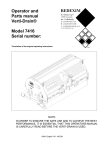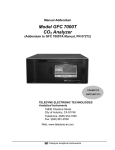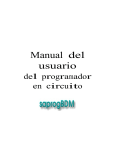Download View User Manual
Transcript
FG-7000T Digital Torque Gauge Operation Manual SHIMPO INSTRUMENTS Operators should wear protection such as a mask and gloves in case pieces or components break away from the unit under test. Whether the unit is ON or OFF, DO NOT exceed the capacity of the sensor. NEVER exceed 120% of the rated capacity, or the torque sensor will be damaged. At 110% of the rated capacity the display will flash a warning. If mounting FG-7000T Series Digital Torque Gauges, use M6 mounting screws with a maximum insertion depth of 7 mm into the gauge. Hand tightens mounting screws, DO NOT use tools. Do not use damaged clamp. Measure in line torque only. DO NOT attempt to measure forces at an angle to the sensor – damage to sensor may result. Do not attempt to repair or alter this instrument. Warranty will be voided and damage to the unit may result. Use and store within the stated temperature and humidity ranges, or damage and failure may result. If not using this instrument for extended periods of time, remove the batteries to prevent potential battery leakage from causing product damage. DO NOT use tools to over torque the connection adapter. Hand-tighten only so damage does not occur. The FG-7000T Series digital torque gauges provide testing flexibility with their external torque sensor input. Torque sensors with standard chuck adapter are immediately recognized when connected to the display base and are available for your specific testing needs in 1 N-m (9 in-lb) 5 N-m (44 in-lb), 10 N-m (88 inlb) capacities. The multiple-language FG-7000T’s provide menu programming for easy selection and set-up of the instrument to your desired requirements. Four selectable modes of operation include: Track mode for live readings, Peak mode for displaying the maximum reading, First Peak where only the initial peak is recorded once a decrease is sensed and Preset which initiates user-programmed tolerance alarms for go/no go testing. The display has two selectable operations, numerical view with directional bar graph or graphical view with directional bar graph. In graphical view when alarm tolerances are set, the process is plotted in relation to the upper and lower limit graph lines. Combined with the go/no go icons, a simple pass/fail determination is recognized. These high-tech instruments can data log a reading at the push of a button for simple data acquisition or be set to continuous data storage. Data can be viewed on the screen, sent to the optional printer, or loaded to be analyzed and graphed on the free software program. The 1,000 point memory with definable groups allows for multiple tests to be recorded and easily separated upon loading. In addition, the comparator output can be set up for integration of the instrument into a quality system for repetitive testing such as on a production line. The FG-7000T’s robust housings are designed to fit perfectly in the operator’s hand for portable testing. The large back-lit, 180° auto-reversible display, CW/CCW directional bar graph, combined with the dual labeled key pad allows for usage of the gauge in various positions while still being able to easily view and operate. These various features make the FG-7000T the ideal torque instrument for various applications such as closing or opening analysis of containers, valves and door hardware, failure or destructive torque testing, or almost any torque testing requirement involving incoming quality inspection, finished goods testing to R&D. SPECIFICATIONS Accuracy: ± 0.3% F.S. Selectable Units: N-m, N-cm, kgf-cm, lbf-in (Depending on Range) Overload Capacity: 120% of F.S. (LCD flashes beyond 110% of F.S.) Measurement method: Peak, First Peak Preset or Track Mode Data Sampling Rate: 1000 Hz Display: 160*128 dot matrix LCD with LED Backlight Display Update Rate: 10 times/second Resolution: (See page 2 Resolution Table) Memory: 1000 data Set Point: Programmable high and low limits Battery Indicator: Display flashes battery icon when battery is low Power: 3.6VDC 800mAH Ni-MH rechargeable batteries Battery Life: Approximately 16 hours continuous use per full charge Charger / Adapter: Universal USB/BM charger, Input: 110 ~ 240VAC Temperature Effects: <0.054% per °F (0.03% FS per °C) Outputs: USB, Serial Port RS-232, High & Low Limit NPN Operating Temperature: 14 to 104°F (-10 to 40°C) Storage Relative Humidity: 20 to 80% Housing: Aluminum Storage Temperature: -4 to 122°F (-20 to 50°C) Oper. Relative Humidity: 5 to 95% Dimensions: 5.7 x 2.9 x 1.4” (145 x 73 x 35.5 mm) Product Weight: 3.7 (1.7 kg) Package Weight: 5.5 (2.5 kg) Warranty: 1 year Included Accessories: Key Chuck, AC Adapter/Charger, USB cable, calibration cert. 1. LCD SCREEN STANDARD VIEW Test Mode Icons: Track: Real Time, live measuring mode Peak: Reading will not change until a higher value is measured Preset: Set the upper & lower limit for GO/NG testing First Peak: Captures First Peak after a decrease has been detected. Drop Ratio set in menus. 4 9 2. Battery Icon: Battery level or charging status. Flashes when gauge needs to be recharged. 3. OK/OV Indicator: 2 Under Lower Limit Between Low Limit & Upper Limit 7 Over Upper Limit Digital View 4. Torque Icons: Indicates force direction. Clockwise (CW) Counterclockwise (CCW) 1 5. Current measured value 6. Analog Bar: Indicates current position within full scale. When the bar enters the area enclosed by the dotted line, this signifies the full scale capacity is exceeded by an overload condition. 7. Storage Icon: Indicates data is being saved. 8. System time 9. Units Indicator: Selected engineering unit. 10. Load Cell Capacity Icon: 3 5 6 If no load cell is connected, this symbol appears & blinks 8 10 Graphic View 2. RESOLUTION TABLE Model 1 N-m 5 N-m 10 N-m 2 N-m N-cm kgf-cm lbf-ft lbf-in Interface Type Capacity 1 100 10 - 8.9 Resolution 0.001 0.1 0.01 - 0.005 Capacity 5 500 50 3.68 44.3 Drill Chuck 1-10 mm (0.034 to 0.39 in) Resolution 0.001 0.1 0.01 0.001 0.01 Capacity 10 1000 100 7.38 88.5 Resolution 0.01 1 0.1 0.001 0.01 Drill Chuck 2-13 mm (0.079 to 0.512 in) 3. KEY FUNCTIONS From the home screen, touch “MENU” to enter the main menu. (Figure 4-1) All keys are capacitive touch. ON/OFF: Push for 2 seconds to power On or Off During Measurement: Print the current force value or store data, depending on the key setting. (See 4.5.8 for key setting) In Menus: Back or quit. During Measurement: Enter the menus. In Menus: Select or Enter During Measurement: Track mode, tares weight of attachment. In Peak & Auto Peak modes, resets the peak value. In Menus: Moves selection up or increases the value. Figure 4-1a Figure 4-1b 4.2 Measurement The Measurement menu contains six selectable items: Unit, Group, Test Mode, Alarm and Calibration. (Figure 4-2a) During Measurement: Changes the measure mode from Track, Peak, Auto Peak, First Peak In Menus: Moves selection down or decreases the value. Figure 4-2a 4.2.1 Unit The measuring unit can be selected under this menu. Different range models may have different unit selection capabilities. Touch “ZERO” or “MENU” keys to shift to the next selection. Press “LOG” to cancel or touch “MENU” to confirm and exit. (Figure 4-2c) 4. ADVANCED MENU OPTIONS 4.1 Menu Structure Unit Group Measurement Test Mode Alarm Figure 4-2c Calibration Storage Mode Browse All Memory Browse Selected Delete Selected Delete All Print Recent Printing Print Selected 4.2.2 Group When several test samples need to be measured, the samples can be coded into groups. The range is 01-99. When set to “00”, become, “01” automatically. Press “ZERO” to adjust the value, touch “MODE” to shift to the next position. Touch “LOG” to cancel; press “MENU” to confirm and exit. (Figure 4-2d) Print All Menu Display Mode Display Direction Auto Power Off Backlight System Key Tone Figure 4-2d Date/Time Password Key Setting RS-232 Baud Rate Default Setting Language Information 3 4.2.4 Test Mode Change the mode of operation between the four modes. Press “ZERO” or “MODE” keys to select. Press “LOG” to cancel or “MENU” to confirm and exit. This adjustment can also be changed at the home screen display by simply pressing “MODE” (Figure 4-2f). First Peak Mode will display a drop ratio menu (Figure 4-2g). This drop ratio actives the first peak recording. Load a standard force on the gauge. Wait a moment for the force to stabilize. The current value (2) should equal the standard force applied. If the values do not match, press “ZERO” and “MODE” keys to correct the standard input value (3). Press “MENU” to enter the next calibration point. After any of the calibration points have been completed, touch “LOG” to exit the calibration mode. Then save the calibration or discard by pressing “Yes” or “No”. After completing the calibration of the 5th point, the confirmation window will automatically ask to “Save and Exit” by selecting “Yes” or “No”. (Figure 4-7c) Figure 4-2f Figure 4-2g 4.2.5 Tolerance In the Preset menu, program high and low limit values to enable ok/ov testing. The lower limit value cannot be greater than the upper limit value, and neither limit value can be greater than 110% of the rated capacity. Press “ZERO” to adjust the value, touch “MODE” to shift to the next position. Press “LOG” to cancel; touch “MENU” to confirm and exit. (Figure 4-2h) Figure 4-7c Press “ZERO” or “MODE” to select, then press “MENU”. If “Yes” is selected, “Calibration Complete!” is displayed. NOTE: 1. Ensure that the tare of attachment has been cleared before calibration. Figure 4-2h 4.2.6 Alarm The alarm function can be turned on or off to activate or deactivate the user programmed tolerances set in the Tolerance Menu. Touch “ZERO” or “MODE” keys to shift to the next position. Press “LOG” to cancel, touch “MENU” to confirm and exit. (Figure 4-2i) 2. For higher measuring precision throughout the test range, calibrating a point with a force at full scale is recommended. 3. Compression and tension calibrations are saved separately. The force gauge can identify the direction of the force, but each must be completed in a separate procedure. 4.3 Memory In the Memory menu, the user can browse, delete, or print the data. (Figure 4-3a) Figure 4-2i 4.2.7 Calibration Users can field-calibrate the gauge. First, enter the system password (Default is 123) by pressing the “ZERO” and “MODE” keys. Then press “MENU” to confirm. (Figure 4-7a) 1 2 3 Figure 4-7a jCalibration Point kCurrent Value lStandard Input Value 4 Figure 4-7b Figure 4-3a 4.3.2 Browse All The data will be displayed. Touch “ZERO” or “MODE” keys to shift to the next position. Touch “MENU” to see Delete or Print options. Touch “LOG” to go back. (Fig. 4-3c) Figure 4-3c 4.3.4 Browse Selected User can choose the data to browse. The available range of data stored is shown. Touch “ZERO” to adjust the value. Press “MODE” to shift to the next position. Press “LOG” to cancel; touch “MENU” to confirm. (Figure 4-3d) Figure 4-3d 4.3.5 Delete Selected Select the range of data to be deleted. Touch “ZERO” to adjust the value. Press “MODE” to shift to the next position. Touch “LOG” to cancel; touch “MENU” to confirm. (Figure 4-3e) Figure 4-3e 4.3.6 Delete All In this menu, a prompt will appear. All data will be deleted by selecting “YES” and canceled by selecting “NO” or pressing “LOG”. (Figure 4-3f) Figure 4-4b 4.4.1 Print Recent Print recently stored data in this menu. The range is 0~19. (Figure 4-4c) Touch “ZERO” to adjust the value. Touch “MODE” to shift to the next position. Press “LOG” to cancel. Press “MENU” to confirm. Figure 4-4c 4.4.2 Print Selected In this menu, select the data range to print. Touch “ZERO” to adjust the value, touch “MODE” to shift to the next position. Press “LOG” to cancel; touch “MENU” to confirm. (Figure 4-4d) Figure 4-4d 4.4.3 Print All To print all data saved in memory, a prompt window will display. All data will be printed by selecting “YES”. This operation will be canceled by selecting “NO” or touching “LOG”. (Figure 4-4e) 4.5 System Figure 4-3f Figure 4-4c Figure 4-4e Under the System menu, several parameters may be set per Figure 4-5a, 4-5b. 4.4 Printing The Printing menu contains three selectable items: Print Recent, Print Selected Print All and Print Diagram. (Figure 4-4a) The data saved in memory can be output to a printer through the serial port RS232 connection. (See 6.2.1 RS232 for more information) An example test report is shown in Figure 4-4b, 4-4c. Figure 4-5a Figure 4-5b Figure 4-4a 5 4.5.1 Display Mode Two display modes may be selected: Digital and Graphic (Figure 4-5c). If diagram is chosen, select the diagram’s scale. (Figure 4-5d) Figure 4-5c Figure 4-5d 4.5.2 Display Direction Select the mode of the LCD display: Automatic, Obverse and Reverse. Touch “ZERO” or “MODE” keys to shift to the next position. Press “LOG” to cancel; Push “MENU” to confirm and exit. (Figure 4-5d) Figure 4-5e 4.5.3 Auto Power Off To maximize battery life, the power can be set to shutdown after non-use. The time can be set in this menu. The range is 01-99 minutes. When set to “99” the gauge will never turn off. Touch “ZERO” to adjust the value, touch “MODE” to shift to the next position. Press “LOG” to cancel; Push “MENU” to confirm and exit. (Figure 4-5f) Figure 4-5f 4.5.4 Backlight Under this menu, the backlight can be set to ON, OFF or have an auto shutdown. Touch “ZERO” or “MODE” keys to shift to the next position. Press “LOG” to cancel. Press “MENU” to confirm and exit. (Figure 4-5g) Figure 4-5g 4.5.5 Key Tone Turn the key sound ON or OFF. Touch “ZERO” or “MODE” keys to shift to the next position. Touch “LOG” to cancel; Press “MENU” to confirm and exit. (Figure 4-5h) 4.5.6 Date/Time The system time may be set under this menu. Touch “ZERO” to adjust the value. Press “MODE” to shift to the next position. Touch “LOG” to cancel. Press “MENU” to confirm and exit. (Figure 4-5i) Figure 4-5i 4.5.7 Password The system password can be changed. First, enter the old password (Figure 4-5j), then enter the new password and confirm the new password (Figure 4-5k). The default System password is “123”. Touch “ZERO” to adjust the value. Press “MODE” to shift to the next position. Touch “LOG” to cancel; Push “MENU” to confirm and exit. Figure 4-5j 4.5.8 Key Setting Set the default function of the “LOG” key from the home screen. The function can be set to print or store the current displayed value. Press “ZERO” or “MODE” to select the proper setting. Press “LOG” to cancel; touch “MENU” to confirm and exit. (Figure 4-5l) Figure 4-5l 4.5.9 RS232 Baurate Adjust Baurate to available bits per second selection in Figure 4-5m. Figure 4-5m 4.5.10 Default Setting If you make a selection that you feel has caused the gauge to operate improperly, you can restore it to the factory default settings. Carefully use this function! (Figure 4-5n, Figure 4-5o) Figure 4-5l 6 Figure 4-5h Figure 4-5k Figure 4-5o 4.6 Language Select between English, German and Chinese (Figure 4-6a) Figure 4-6a 4.8 Information Information includes the model, version of the software and the serial number. (Figure 4-8a) 1N-m SN Figure 4-8a 5. CHARGING The FG-7000L Series Digital Force Gauge is supplied with a set of 3 Nickel Metal Hydride AAA rechargeable batteries, which are supplied fully charged to allow immediate use. Users need to recharge batteries when a low battery icon flashes. Users should connect the gauge and the charger using the USB cable. Then connect the charger to an AC socket to start charging. Laptops and other USB devices can also charge the gauge. A fully charged battery pack will provide approximately 16 hours of constant use. Rechargeable battery pack: - Type: Ni-MH 3.6VDC 800mAH rechargeable batteries -Charging time: approx. 3~4 hours -Battery life: approx. charge and discharge 500 times 6. COMMUNICATIONS 6.1 USB The FG-7000L Series Digital Force Gauge is designed in accordance with USB2.0 standard protocol. (Figure 6-1a) The USB Port can be connected to a charger with the USB cable for charging the internal Ni-MH battery and can be connected to a computer for uploading the measured values. Connect the gauge and the computer with the USB cable, then open the computer software. Upload the values. Please refer to the software manual for additional information. Figure 6-1a 6.2.1 RS232 The RS232 serial port is used to connect a printer to print the memory data. RS-232 specifications are as follows: -Data transmission: serial interface -Synchronization: asynchronous -Signal Level: RS-232 level, logic 1:-5v, logic 0: +5v -Hardware Flow Control: None -Data word length: 8 bits -Stop bit: 1bit -Parity: None -Baud rate: 38400 6.2.2 Comparison Output Comparison Output internal circuit shown as Figure 6-2a. When the measured value is less than the lower limit tolerance value, the “pc2” operates, 7pin and 6pin line conduction. When the measured value is more than the upper limit tolerance value or 110% of the rated capacity, the “pc1” operates, 4pin and 6pin line conduction. Maximum permissible voltage: 7pin to 6pin, 4pin to 6pin 35V; 6pin to 7pin, 6pin to 4pin 6V. 7. MISC. 7.1 Parts List 6.2 Port Pin Assignments Sensor PIN# Definition 1 RS232-Transmit 2 RS232-Receive 3 RS232-Ground 4 Comparison Output B 5 Reserved 6 Comparison Output C 7 Comparison Output A 8 Reserved Figure 6-2a Key Chuck Not Shown Indicator Charger Manual USB Cable 7 7.2 Diagram Sensor Adapter Connection 160*128 Dots LCD (See LCD Screen) Robust Metal Housing Capacitive Touch Keys USB Port: Recharge the internal Ni-MH battery or connect to PC Communications Port (See Figure 6-1a) 7.3 Dimensions Torque Sensor Dimensions Capacity D0 L0 L L1 D1 L2 1 N-m Ø 40 48 156 88 Ø 42.8 216 5 N-m Ø 46 48 156 88 Ø 42.8 216 10 N-m Ø 46 48 178 88 Ø 52.8 240 ELECTROMATIC Equip’t Co., Inc., 600 Oakland Ave, Cedarhurst, New York 11516 - USA Tel: 800-645-4330 / 516-295-4300 Fax: 516-295-4399 Web: CheckLine.com Email: [email protected]








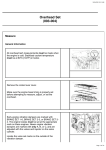


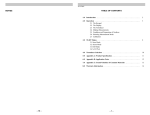

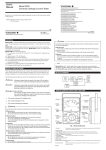
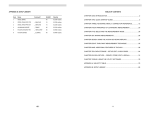



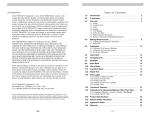

![j:j_"Xt$l"j:]:":,lg]:"r/Human Resources have been duty - e](http://vs1.manualzilla.com/store/data/005657435_1-26d97049bf04f0fd92265d73e45a9ab3-150x150.png)
